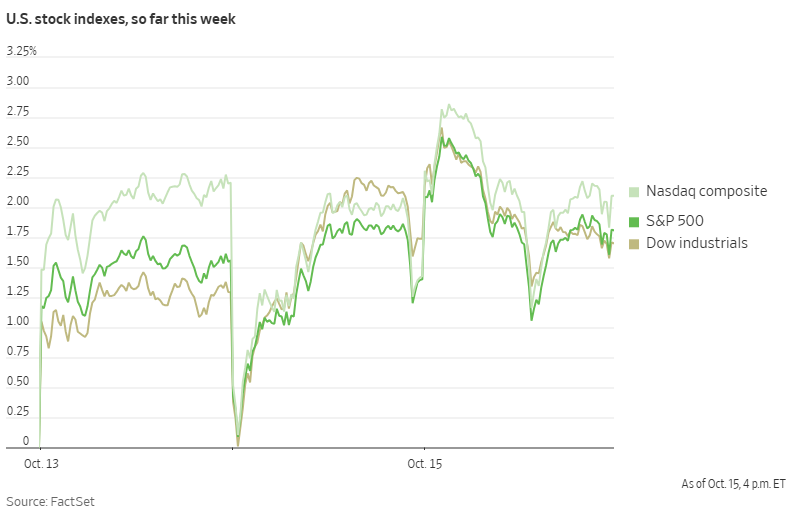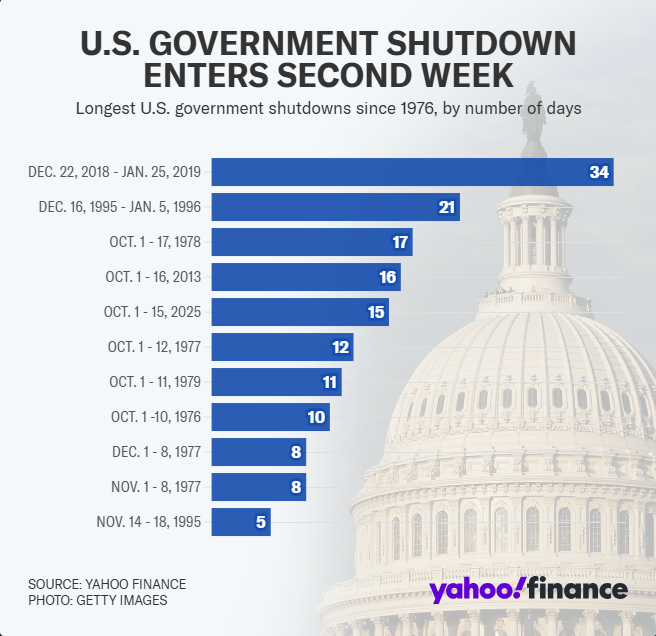Noticias del mercado & perspectivas
Anticípate a los mercados con perspectivas de expertos, noticias y análisis técnico para guiar tus decisiones de trading.

S&P 500 and ASX Rally as Big Banks Drive Markets
Both the S&P 500 and ASX have rallied on the back of stronger-than-expected major bank earnings reports on both sides of the Pacific.
In the US, Bank of America reported a 31% year-over-year increase in earnings per share at $1.06, exceeding Wall Street's estimate of $0.95. Meanwhile, Morgan Stanley delivered a record-breaking quarter with EPS of $2.80, a nearly 49% increase from the same period last year.

On the Australian front, the benchmark ASX 200 leapt 1.03% to 8990.99, with all four major Australian banks playing a major role. CBA closed 1.45% higher, Westpac 1.98%, NAB 1.87%, and ANZ 0.53%.
These strong bank results indicate broader economic strength, despite recent concerns about US-China trade tensions. US Treasury Secretary Scott Bessent emphasised that Washington did not want to escalate trade conflict with China and noted that President Trump is ready to meet Chinese President Xi Jinping in South Korea later this month.
With the third-quarter earnings season just getting underway, these early positive results from financial institutions could prove as the start of continued market strength through to the end of the year.
U.S. Government Shutdown Likely to Last Into November
Washington remains gridlocked as the U.S. enters its 16th day of shutdown. With no signs of compromise on the horizon, it appears increasingly likely the shutdown will extend into November and could even compromise the Thanksgiving holiday season.
Treasury Secretary Scott Bessent has warned "we are starting to cut into muscle here" and estimated "the shutdown may start costing the US economy up to $15 billion a day."
The core issue driving the shutdown is healthcare policy, specifically the expiring Affordable Care Act subsidies. Democrats are demanding these subsidies be extended, while Republicans argue this issue can be addressed separately from government funding.
The Trump administration has taken steps to blunt some of the shutdown's immediate impact, including reallocating funds to pay active-duty soldiers this week and infusing $300 million into food aid programs.
However, House Speaker Mike Johnson has emphasised these are merely "temporary fixes" that likely cannot be repeated at the end of October when the next round of military paychecks is scheduled.

By the end of this week, this shutdown will become the third-longest in U.S. history. If it continues into November 4th, it will surpass the 34-day shutdown of 2018-2019 to become the longest government shutdown ever recorded.
This prolonged shutdown adds another layer of volatility to markets. While previous shutdowns have typically had limited long-term market impacts, the unprecedented length and timing of this closure, combined with its expanding economic toll, warrant closer attention as we move toward November.
Trump Announces Modi Has Agreed to Stop Buying Russian Oil
Yesterday, Trump announced that Indian Prime Minister Narendra Modi has agreed to stop purchasing Russian oil. He stated that Modi assured him India would halt Russian oil imports "within a short period of time," describing it as "a big step" in efforts to isolate Moscow economically.
The announcement comes after months of trade tensions between the US and India. In August, Trump imposed 50% tariffs on Indian exports to the US, doubling previous rates and specifically citing India's Russian oil purchases as a driving factor.

India has been one of Russia's top oil customers alongside China in recent years. Both countries have taken advantage of discounted Russian oil prices since the start of the Ukraine invasion.
Analysis suggests India saved between $2.5 billion to $12.6 billion since 2022 by purchasing discounted Russian crude compared to other sources, helping support its growing economy of 1.4 billion people.
Trump suggested that India's move would help accelerate the end of the Ukraine war, stating: "If India doesn't buy oil, it makes it much easier." He also mentioned his intention to convince China to follow suit: "Now I've got to get China to do the same thing."
The Indian embassy in Washington has not yet confirmed Modi's commitment. Markets will be closely watching for official statements from India and monitoring oil trading patterns in the coming weeks to assess the potential impact on global energy flows and prices.
Chart of the Day - Gold futures CFD (XAUUSD)


We all know the market term ‘don't catch a falling knife’. And in the current market conditions why would you? But with indices, the likes of the magnificent 7, industrials and banks doing so well in 2024 people are asking where's the value?
And that is why people chase falling knives, because they perceive this value. They perceive that if others are doing so well these beaten up companies should surely catch up and therefore give them a big windfall. So we wanted to go through some of the 20 big stocks in the US that are down 20 plus percent or more in 2024.
You will know the majority of these names they show up in everyday life and across all sectors and industries. The interesting thing about them is that they are very diverse across pharmacies, industrials, streaming firms, financial firms and more and that's why there is a huge caveat to this list. Because the majority of these 20 plus losers have structural reasons as to why they have lost 20 plus percent.
Let's really have a look at some of those that are probably an interesting opportunity, take Nike for example. NIKE is down to 30.4% year to date and 41.1% from its 52-week high. Compare that to its main European competitor in Adidas up 23.7% year to date and only 9% off its 52-week high Year to date performance of NKE to ADS So should you catch the Nike falling knife?
Well first and foremost the issues hitting NIKE have been some external issues, but mainly internal ones. Sponsorship deals with Olympic teams have been higher than expected and have hit cost, while on the revenue sign uptake of Olympic branded apparel is below historical Olympic standard. Then there is the deal with the German National Football team, something now he thought was a coup having booted Adidas off what has been nearly a 6-decade partnership.
However this turned out to be something much less profitable than Nike thought explains its current conundrum and share price poor performance. The answer to the falling knife question with NIKE will probably be answered over the next three weeks as the Paris Olympics take off and apparel numbers come in. Therefore it is possible that now he could recuperate some of the losses had seen on its share price pretty rapidly but again we always caution catching a falling knife but it is one to watch.
Which brings me to the next falling off to really have a good look at paramount global. The content and streaming giant has had a really tough time in 2024. Down 23% year to date and 34.2% from its 52 week high the streaming giant is facing cost blowouts, content competition and legacy issues to its cable and freeway TV programming.
There's always been a discussion that the streaming wars would come to a head sometime early after COVID-19. With over 30 different streaming providers competition is so high and costs ballooning that sooner or later a consolidation will come. The question is will paramount the first major player to fall in what probably will be a house of cards scenario?
Let's have a look and compare it to some major players like Disney and Netflix. As this chart shows both Netflix and Disney are still up in 2024 how Disney has had some structural issues around its amusement parks Netflix on the other hand is on a tear. This chart clearly shows paramount's biggest problem.
It's not the biggest provider like it Once Upon a time was, it is coming up against really stiff competition in Netflix and outside of cable it doesn't really have a diversified revenue stream like Disney. What's more it's facing real legacy issues with its free to air and TV services in general. Whenever you see a firm ‘slimming to greatness’ by cutting costs and slashing services it is an immediate red flag and normally suggest that this further to fall before the knife actually finally hits the floor.
Paramount will still be Paramount it will still produce content people want to see but in the current environment and the competition it faces you will not be the Paramount of yesteryear. Finally let's have a look at some of the other major names that sit on this list: Lululemon Athletica is down 44.6% year to date and 45.3% from its 52-week high. Like all things in consumer discretionary apparel is one of the key areas facing the biggest headwinds and lululemon is not immune.
Online e-commerce player Etsy is also facing similar problems down 23.7% year to date and 39% from its 52-week high. Etsy is a small item provider with high turnover which means volume is the key. In a world where people are battling the cost-of-living, small items are easy to go by the wayside.
Finally we come to Walgreens Boots Alliance - the worst performing big cap player on the S&P 500. Down a whopping 57.4% year to date and 64.8% from its 52-week high WBA is in freefall. We need to go through why Walgreen Boots is getting absolutely towelled up.
First and foremost, you need to understand the shift in the US around health care services. Players like Walmart, Kroger and CVS have all expanded their health care services from in store and beyond. Walgreens certainly reacted to this shift and spent heavily in this area spending $8.9 billion to acquire Summit-Healthcare City to compete.
But the plan eventually failed and saw then CEO Roz Brewer fall on her sword. New CEO Tim Wentworth 's basically unwinding the health service position by trying to wind down the company’s investment in Village MD and divesting parts of the Summit-Healthcare City acquisition. But again like Paramount – slimming to greatness is not a strategy that has really worked longer term.
So what is Walgreens Boots Alliance going forward? If it's not trying to take on main competitors in healthcare services WBA is basically saying it's a retailer that just happens to be selling healthcare products. In Australia that certainly works for a player like Chemist Warehouse but in the US competition is much higher and thus margins smaller and overall revenue growth in the sector is anaemic 2% per annum.
This explains the share price fall that we've seen in WBA but the final humiliation came in the last month. WBA has now dropped below a market cap of US$10 billion and that means it can no longer be included in the NASDAQ 100. Being sold out of index funds has only ramped up further selling in this once large firm.
This normally signals the final shake out of a share price and the falling knife that is WBA is clearly coming towards the bottom, a bounce is probable. But with its current strategy it is unlikely to recuperate historic highs anytime soon.


There is a clear and present danger in trade at the moment – overconfidence. Overconfidence that policy and private capital will align and deliver trader a bullish windfall. However, from where we sit, this overconfidence should be defined as likely-disappointment.
Let us explain. China 2024 is not China of 1994. After a week away for Golden Week celebrations, there was a hype ahead of Tuesday’s National Development and Reform Commission (NDRC) briefing.
The hype was clearly at disproportionate levels. But the hype was not completely unjustified after broad fiscal intervention several weeks ago that included interest rate reductions and liquidity injections by the People's Bank of China suggested that China might be returning to policy moves of the 90’s, 00’s and 10’s. What the market got was anything but.
NDRC announced that it would advance 100 billion yuan (about $21 billion) from next year’s budget to enhance local government investment and…that was it. Full stop. The NDRC then basically reiterated existing policies, such as support for migrant workers and recent graduates.
NDRC Chairman Zheng Shanjie expressed confidence in achieving the nation's economic targets, aiming for a growth rate of "around 5 per cent." Disappointment with a capital D. Beijing had signalled a renewed appetite for bolstering economic growth through monetary interventions in recent weeks, but investors and economists are increasingly looking for fiscal measures to sustain market optimism and address real structural concerns. One of the biggest structural issues, youth unemployment—which neared 20 per cent in August— which is weighing on China's economic outlook.
While the government has pointed to emerging job opportunities in sectors like electric vehicles (EVs) and drone operations, the broader transition toward a green economy has not been enough to sustain growth. Projections for China's full-year GDP growth have slipped to 4.8 despite the government suggesting it will be ‘around 5 per cent’ To give more context about the expected stimulus, have a look at some of the market analyst forecasts ahead of Tuesday’s announcement: Morgan Stanley had projected a fiscal package worth around 2 trillion yuan ($952 billion), potentially aimed at infrastructure spending and local government financing. Citigroup was even more optimistic forecasting a 3 trillion yuan package ($1.4 trillion), with possible allocations for social welfare and banking sector recapitalisation.
Markets reactions were that of confusion – initially Chinese equity markets, including the CSI 300, surged but quickly retreated back to lower levels. The Hang Seng plummeted correcting 10 per cent marking its steepest decline since 2008. The overconfidence from the market coupled with Beijing raising expectations to fever pitched levels show the trap that is presenting in markets currently.
Interestingly enough without new fiscal stimulus, the world’s second largest economy will face continued challenges, particularly given China’s structural issues such as high youth unemployment. All this is leaving market participants speculating on how the government plans to address local government debt and financial stability. Because despite hopes for a more aggressive fiscal push, such as direct consumer stimulus, Tuesday’s announcement has now left analysts in a quandary and have start to doubt official channels.
This is now leading traders and investors alike to now dismiss the likelihood of demand-driven stimulus in the near term and have moved to a "wait-and-see" approach regarding Beijing's commitment to reflation. All of which is seeing Chinese indices and Chinese-exposed sectors giving back significant gains of the past 2 weeks. China isn’t the only one – RBA is on a collision course to disappoint We also need to warn about the state of the Reserve bank of Australia.
As recently as October 8 economists are forecasting on a consensus basis that the first rate cut of the upcoming cycle will occur in February. However, how that conclusion is being reached is hard to understand when you look into recent statement and then the minutes from the recent September meeting. The minutes reflect a moderately more hawkish view of the RBA's Statement and Press Conference, which is the third time this year this has happened.
We should point out that RBA Governor did not aim for a dovish tone during the press event it was more ‘neutral’. But when pushed on things like ‘considering hikes.’ She suggested it was not which was construed as a more dovish view. The minutes however revealed a different story with the Bank keeping the option of raising the cash rate on the table, as financial conditions have eased, potentially complicating efforts to bring inflation back to target.
While the second quarter GDP household consumption component was weaker than the banks had forecasted, the Board believes it's too early to judge whether this will continue. A point backed by the last consumer confidence number that saw confidence back at level now seen since the start of the rate hiking cycle. Thus, the outlook for improving consumption remains unchanged.
Then there is the labour market which remains tight. The Board believes labour conditions are consistent with an economy close to full employment, noting that "the share of unemployed people finding jobs was high and the share of workers losing jobs was very low." A further positive is the participation rate increasing is likely due to readily available jobs, demonstrating an "encouraged worker effect" rather than more people falling out of work. The minutes also show that policy discussions leaned hawkish.
Board members felt that “not enough had changed since the last meeting” to alter their view that the current cash rate was the best balance between inflation risks and labour market conditions. They discussed what kind of data might warrant more restrictive monetary policy, such as stronger consumption or tighter supply combined with weaker productivity. Additionally, even if the Board's outlook is correct, if financial conditions aren’t restrictive enough to bring inflation down, “monetary policy may need to be tightened.” Eased financial conditions and rising credit growth over the past few months made this scenario more plausible, and banks appear well-positioned to meet any increase in credit demand.
All this – suggested Australia is facing the same situation the US faced in 2024. That being later than forecasted rate cuts by upwards of 6 months. All growth in indices, risk and currencies is based on rates being cut early.
The reactions to ‘disappointment’ are likely to be high and we are mindful that overconfidence in positioning will lead to trading issues. Watch this space.


Market action and underline breath of the last two and half weeks has been extreme and rather eye opening. The S&P 500 has made 38 record all time highs in 2024 so far, however since its most recent peak on July 16 it has traded lower ever since. Now we need to put that into perspective, the pullback since its July high is 4.75 percent to date.
The pullback that we saw in April was 5.7 per cent, the rally at the end of the April pullback was 14.1 per cent to that July 16 high. And overall the S&P 500 is still up 6.6 per cent year to date. But what's really catching our attention is that the pullback in the second half of July looks very much like the pullback that started in July 2023.
If we compare the SNP's year to date performance in 2023 to what we have seen today in 2024 the correlation is surprisingly tight. Have a look at this chart. Yes, the path of the market in the first quarter of 2023 was different to what happened this year but by the end of March (2023 and 2024) the S&P was up a similar amount on a year to date basis.
What we can then see is that from the start of the second quarter through to mid-July that correlation is really tight. So the question we're now asking is are we going to experience déjà vu? The pullback that began in late July 2023 went all the way through to late October 2023 Started slightly lighter than what we've seen this year.
But as the price action shows if we follow what happened last year we could be in for a couple of months of high volatility and the Bulls quickly reassessing their current trajectory. It's going to be interesting because unlike in 2023 where the issues came for monetary policy and the prospect of rate rises or cuts. 2024 has an external factor we only experience every four years and that's a U.S. presidential election. And what might be a trigger point for the bottom of the market if we are about to experience a multi month pullback would be the November 5 election.
Second to that is that all things being equal a rate cut or cuts will have happened by the end of October something that didn't happen in 2023. What's hard to equate is the impact one or more cuts will have on indices in particular as according to the market pricing it's already factored in. It's why the current pullback although close to 2023 the deja vu we are experiencing right now is just that deja vu and not something to be factored into your thinking.
What’s going on in FX? What we are watching very closely on a monetary policy and FX perspective is this coming Wednesday's CPI read in Australia. Over the last 2 1/2 weeks the AUD has been savaged.
So much so that several traders have exited their bullish positions in the Aussie. It's not hard to see why with the AUD/USD losing some two cents in this. Yes this is down to USD strength on the back of a change in the democratic candidate,risk increases in markets, and signs of economic reactivity in the world's largest economy.
But it's not only the AUD/USD but it's saying movements of this kind of magnitude news over the last week and a half of intervention by the Bank of Japan has seen the JPY recuperate some of the losses experienced this year. Again using the Aussie dollar as an example AUD/JPY moved from a high of ¥107.56 to as low as ¥100.5 inside 10 days. This all suggests that at the moment FX is probably ignoring fundamentals and is being caught up in short term external factors.
It is why this coming Wednesday's CPI numbers could be a real turning point in the trading of FX of the last few weeks. Because it should sharpen traders' minds back to the fundamentals. As this chart shows, the expectation of a rate rise on August 6 has been as high as 27 percent in fact at one point in the last two months it's been as high as 46 per cent.
This in our opinion has been fully factored out of FX trading in the Aussie over the last couple of weeks. Thus, if Australia’s trimmed mean inflation rate comes in anywhere north of 3.9 per cent year on year. This chart should rapidly change and be pricing in the probability of a rate hike as high as 80per cent for the August 6 meeting.
What this means for FX is that the current sell off in the AUD is probably overdone and will rapidly unwind itself. Those bulls that have been shaken out over the last week and 1/2 will more than likely reinstate positions. Crosses that have been savaged are also likely to face a rapid snapback because from what is currently presented in the data suggests the Aussie is more fairly valued where it was two weeks ago rather than where it is now.
The caveat If however Australia is trimming inflation rate comes in at or below 3.9 per cent. Then the current pricing of the Aussie is probably fair, and the reaction is likely to be negative. All pricing this year in the local currency has been on the premise of an improving China which is yet to materialise and the divergence that's happening at the RBA.
If inflation indeed is showing signs of finally declining in Australia then there will be a reaction to the downside because the probability of a rate increase in 2024 will drop back to almost 0, as there will be no data strong enough to convince the RBA to raise rates again is there a hesitant hawk something we discussed 4 weeks ago. We will do a full report on the CPI next week and how to trade it leading into the August 6 RBA meeting.


The horrible events that we're currently seeing in the Middle East can sometimes create an unwanted attraction for traders. Chasing short, sharp swings in things like oil and other commodities of this ilk, might appear attractive for the here and now upside opportunity but be aware geopolitical trading always ends in bad outcomes. This is why we want to point out in this article the avenues you could consider with geopolitical risk in the Middle East.
These include impacts on things such as shipping, auto industries, consumer and retail goods, soft commodities etc. While we highlight this is because it gives you more time and a better fundamental understanding of the structural impacts that could positively and negatively impact these industries. Trying to predict actions and reactions of geopolitical outcomes will always lead to bad trades.
Backgrounding Biggest playbook from a trade perspective in the Middle East is what happens to the Red Sea And by extension the Suez Canal. The impact the Suez Canal has on global supply is astounding. 30% of global container traffic travels through this straight and into the disputed area of the Red Sea. It is an essential artillery for international trade, particularly economic centres of Europe, Asia and North America.
Possible disruptions to the supply chain could lead to widespread logistical challenges particularly those that rely on the minute delivery time systems. We have already seen examples of what may happen now at the start of the year. In late January early February the Red Sea was the centre of attacks by Houthi rebels on cargo ships and tankers, creating major disruptions in global maritime trade.
The resultant behaviour or global logistics was to send hundreds of vessels around the significantly longer Cape of Good Hope route southern, adding approximately 6,500 kilometres to their journeys. This detour led to inflated transit times, freight costs, and caused supply chain bottlenecks leading to a re-inflation issue worldwide. Before we play that out in the current environment, inflated transit times heightened freight costs supply chain bottlenecks coupled with interest rate cuts and central banks trying to reignite economies - could we be looking at interest rate hikes to offset this in 2025?
Does it also lead to higher levels of spoilage waste and poor products that demand lower pricing despite lower goods? These are all questions that need to be considered and questions that give traders time to position a manoeuvre in What is normally a rapidly changing trading environment. Here’s a detailed look at how this crisis could affect global supply chains, shipping costs, and inflationary pressures.
Automotive Industry: The global auto industry would be among the hardest hit by a Red Sea crisis. European auto manufacturers, which rely heavily on parts sourced from Asia, announced temporary production halts at the start of the year when the Red Sea was closed. The European market is particularly dependent on Chinese exports of new-energy vehicles (NEVs), which are primarily shipped by sea, and the extended shipping times could have serious consequences for auto production schedules, vehicle availability, and pricing.
Further stressing the resilience of the automotive supply chain, especially if these delays come on top of existing disruptions in global semiconductor supply — a key component for both conventional and electric vehicles. Suppliers, particularly those with significant revenue exposure from China to Europe and the U.S., will feel the impact of extended lead times and will lead to share price impacts. Consumer Goods Retailers both in Europe and Asia rely heavily on sea freight for inventory replenishment.
Shipping delays that could disrupt product availability, particularly for time-sensitive items such as seasonal goods are plays traders need to watch. While some large retailers have and will hedge against freight rate increases by locking in shipping rates through the second half of 2024, they are not entirely insulated from further disruptions. If supply chain bottlenecks worsen, they may face difficulties in securing stock, especially for goods sourced from Asia, potentially leading to stock shortages and rising consumer prices in the European and Mediterranean markets.
Manufacturing and Industrial Supply Chains: The broader manufacturing sector, including electronics and heavy machinery, is also at risk. Extended shipping times will likely affect lead times for raw materials, intermediate goods, and finished products which in turn leads to slowing production cycles. Again, if we use the impacts from February as a baseline example the rerouting of vessels around the Cape of Good Hope saw an increase in transit times by about 30%, translating to a 9% reduction in global shipping capacity.
The impacts this time would be of a similar nature. The unknown is the length of time the delays and closures will be in place. Along with the conflict drags on the more bottlenecks it will create.
The reduction in capacity creates ripple effects across various industries, as businesses are forced to manage longer delivery times, increased uncertainty, and higher costs for shipping essential goods. Considering the likes of France, Germany and Italy are major high-end manufacturing players. These the markets traders should be looking at closely along with the impacts trade might have on the currency.
Again using February as the example, the EUR fluctuated rapidly during this time as data points released in March through to June showed these three nations and the periphery struggled economically. A similar issue is likely this time around as well. The final conclusion from the horrible events that we are seeing in the Middle East is again beware of geopolitical trade.
We cannot emphasise this enough chasing risk both up and down the momentum trade will lead to undue risk taking and probable loss. The evergreen lesson from these kinds of events is not to look at the ‘now’ but look at what happened previously when these have occurred as the probable outcomes this time around. History never repeats itself, but it does follow a similar pattern.


2024 continues to be an interesting year for FX. Even more now that the starters gun has been fired with the European Central Bank (ECB) and Bank of Canada as well as the likes of the Riksbank and SNB all starting to their respective cash rates from COVID peaks. This brings us to the next stage – who is next, who is going the other way and where does that leave pairs and crosses?
Well let's start with the biggest gorilla in the pack The US Federal Reserve. We have to start here because the US dollar at the moment is in an interesting conundrum: it has dovish to neutral leaning central policy which in theory overtime should put a downward trajectory in the dollar, but has been holding or moving to the upside against majors as its investment outlook rights and overall attractiveness outweighs the negative bias of a dovish position. The question also remains how Darvish is the outlook for rate cuts from the US Federal Reserve?
Markets have a bias for the Fed to start rate cuts in September with 18 basis points. That equates to about a 68% to 71% chance. May's softer core PCE inflation data that dropped last week supports the likelihood of cuts due to slowing inflation.
Core PCE inflation came in at 0.08% month on month, well below the expected 0.15%. The faster decline was due to lesser-known components, such as non-profit prices and imputed financial services which have now slid for three consecutive months (something we would like to see in Australia) should encourage Fed officials. But the market has been hesitant to react to the PCE why?
Clearly the Fed’s language and actions of late suggest it needs more evidence of easing inflation is sustained. This could be achieved with another favourable read for the June numbers which are due out at the end of this month. We also note that revisions to April’s core PCE were modest (were revised up), and May’s weaker data might indicate a positive trend in Q2.
Remember this is the Fed core measure of inflation and needs it to be at or around 2%. Dollar Basket Yet once again we come back to the USD – its lower compared to pre-PCE trading but not by a margin that gives confidence the Fed is going to cut rates in the coming months. Which suggests we need to break out the pairs and look more directly at actions.
EUR/USD If you look at EUR/USD, the biggest player in the DXY, the easing bias from the Fed is there. Not only that since the ECB cut rates last month there has been a growing belief the Board will hold off to see the reactions across the zone before acting again. Inflation in the likes of Germany, France and Italy are so varied it hard to get a proper read on the overall composition of the eurozone which is going to make it very hard for the ECB and its board's decision making.
Explains why the initial decrease in the euro has subsided. We also can't write off the elections that are going on inside France right now. The rise of the far right nationalistic protectionism parties clearly also is a threat to the eurozone and therefore the euro itself.
However with that in mind if you look at the central bank differentials between the ECB and the US Federal Reserve. It is clear that there is more of a dovish bias from the Fed (as they should be) and it's more likely the Fed is going to move next rather than the ECB. Listening to Fed talkers like Governor Cook who expects cuts soon.
Then there are the doves like San Francisco Fed President Mary Daly that are razer focused on unemployment. She described the risk that “future labour market slowing could translate into higher unemployment, as firms need to adjust not just vacancies but actual jobs.” She stated that past tolerance of high unemployment to curb inflation like that in the 1970 and 1980 was not tolerable – suggesting that inflation is not the only trigger there. Governor Cook downplayed recent strong job growth, citing overstated payroll gains and a slower true pace of job gains.
Weak labour data this Friday (non-farm payrolls) could signal rate cuts at the July FOMC meeting. On the NPF the consensus is for a slower 155,000 increase for the month of June. The unemployment rate is projected to stay at 4.0%, and average hourly earnings should rise by 0.4% month on month.
The Fed's June meeting minutes this week will likely show higher 2024 rate cut projections, with officials needing more data to be confident in sustained inflation reduction. In short, USD data is forecasted to be bearish. So it’s about choosing your pairs wisely and clearly things like EUR, GBP, CAD etc. are difficult to deal with currently as each is facing a bearish issue of their own.
Thus let us finish on a differential that is clear – the RBA versus the Fed and the Bank of Japan. AUD/USD Although AUD/USD hasn’t completely broken out of its 0.661 to 0.669 range. The slow uptrend momentum is building.
The test as we described last week is the July 31 CPI print. The minutes from the last RBA meeting were telling – there are only two options on the table, hold or hike and the argument for a hike was well made and without the May monthly inflation read. A print above 3.9% August 6 is basically a lock putting the RBA out of sync with the rest of the G10.
The differential here is glaring and one of the most bullish signals for the AUD. We watch the AUD/USD for signals that uptrend is on. Which brings us to the final cross to discuss.
AUD/JPY The trend is clear and the different responses between the BoJ and the RBA couldn’t be starker. The BoJ has lost control of its currency and is unable to provide stability. The pressure it's experiencing is real and with next to no inflation Japan is facing a difficult situation of dealing with capital outflows while needing to be accommodative.
Count that with the RBA that has the highest cash rate in 12 years, highly attractive yields and. The possibility of further increases – cash inflows are glaring. The cross has been capping out at Y107.5 but once again July 31 is key – inflation signalling rate hikes and AUD/JPY will be chasing Y108 and beyond.


If you look at equity markets in particular, you'd think everything smelled of roses. For the 47th time this calendar year US indices have made record all-time highs and 46 times at record closing highs. Earning season is underway and so far, it is doing what it always does, which is beating the Street 75 percent of the time.
Banking, Tech and industrials are the standouts. And even when you look at the 493 non magnificent 7 stocks on the S&P 500 the gap between the seven and the rest is finally starting to close up. So all is well at least that's how it appears.
However over the next 20 days the risks that are facing global markets cannot be understated. First and foremost is the US presidential election. As we point out in our US 2024 election specials, the margin between Trump and Harris has never been closer.
In fact, most probability markets now have Trump ahead. Predictit for example, Trump leads by three points and on RealClearPolitics it's even larger sitting at 10.8 points. Most of the key states or swing states are statistical dead heat but on average Trump is now ahead by 0.2 at 47.7 to 47.5.
Whichever way you look at it, whoever wins on Election Day, it will lead to disputes and the other side is unlikely to accept the result. The political upheaval will filter through into markets, and we need to be ready for that. What has also been lost in geopolitics and the incredible run in equities is movements in the bond market and the risks around US inflation.
And it is this that we need to take a closer look at. Trends and Key Drivers in US Inflation Blink and you will have missed it, the back end of the USU curve is back above 4%. This is down to several risk factors, The US presidential election being one, employment being another, and then the big one inflation rearing its head in September.
There was an unexpectedly strong rise in CPI inflation for September. So is there some going on here or is it just a false flag? First things first - Core PCE inflation continues to trend at a consistent pace of approximately 2 per cent on an annualised basis.
This suggests that inflationary pressures, while present in some sectors, remain largely in check but risks remain. So what are the keys here? Key Factors on the Inflation Outlook: 1.
Core CPI Outperformance and PCE Expectations: September's core CPI surprised with a 0.31per cent month-on-month (MoM) increase, surpassing consensus forecast of 0.25 per cent. While this unexpected rise is noteworthy, the details of the PPI (Producer Price Index) data suggest a more moderate increase in core PCE inflation, estimated at 0.21per cent MoM for the same period. The issues in the inflation figures however remain in components such as shelter and insurance, which had been driving much of the previous increases, with weather events and housing price volatility expect inflation fluctuations here to persist in the near term.
The upward surprises in the headline CPI data were concentrated in volatile categories like apparel and airfares. Airfares, for instance, rose by approximately 3 per cent MoM on a seasonally adjusted basis. 2. Wage Growth and Labor Market Dynamics: The Atlanta Fed’s wage tracker indicated that wages picked up in September, with the unsmoothed year-on-year (YoY) measure reaching 4.9 per cent, up from 4.7 per cent in August.
Additionally, the 3-month smoothed measure and the overall weighted average both rose to 4.7 per cent, compared to 4.6 per cent in the previous month. Whichever measure you want to use, real wages in the US are growing at about 2.5 per cent. While this wage growth exceeds the rate typically consistent with a 2 percent inflation target (in the absence of significant productivity gains), it remains only modestly stronger and isn't a concern, yet.
It’s worth noting that wage growth may take longer to cool off, particularly given seasonal patterns in early 2024 and the effects of recent labour strikes in sectors like port operations and aircraft manufacturing, both of which have underscored the potential for more persistent wage inflation. Interestingly, the Atlanta Fed wage data revealed a sharp deceleration in wage growth for job switchers compared to job stayers. Normally, job switchers see higher wage increases, but over the past few months, the growth rates for both groups have converged.
This shift may signal weaker demand for labour and could be a key indicator of wage trends in the coming months. However, wages for current employees may lag behind, requiring time to adjust downward, much like how rental prices for new leases often move ahead of existing rents in shelter inflation. This dynamic suggests that wage pressures might remain elevated for a time, particularly if companies raise wages for existing employees to catch up with the now-slowing wage increases for new hires.
The ongoing wage growth for current employees could also keep hiring demand subdued, as firms may focus on managing costs rather than expanding their workforce only time will tell here. 3. Potential Impact of Hurricanes Helene and Milton: The inflationary impact from Hurricanes Helene and Milton are yet to be factored into most forecasts and thus it is important to acknowledge the potential for volatility in certain inflation components. Historically, hurricanes have primarily affected gas prices by disrupting supply chains.
However, there has been only minimal upward pressure on retail gas prices so far. Demand led cost in infrastructure and construction supplies also tend to increase post hurricanes as the clean-up and rebuild takes precedence. Another major CPI component that has historically shown sensitivity to hurricane-related disruptions is "lodging away from home." For example, in the aftermath of Hurricane Katrina in 2005, lodging prices initially dropped before rebounding the following month.
It remains unclear whether the recent hurricanes will affect hotel or recreational service prices in Florida, which were among the areas impacted. September CPI already showed weaker-than-expected data for lodging, and with discretionary spending on services potentially declining, this component could face further downside risks. However, if there is an unusually sharp drop in lodging prices for October, any hurricane-related distortions might result in a bounce-back in November CPI.
This is why we think the market needs to remain cautious on core PCE inflation. Will it stay modestly higher than the Fed’s 2% target over the near term? It's clearly possible.
Then there is the ongoing volatility in certain sectors and potential risks from external shocks like hurricanes mean inflation forecasts could still see adjustments. All in all we remain vigilant that despite the enthusiasm and bullishness in indices risks are building and traders need to be vigilant.

